Halifax Minster
The centre of worship in Town

Halifax Minster is the minster church of Halifax. The church is dedicated to St John the Baptist. Formerly the parish church of the town, it was granted minster status in 2009. Halifax Minster is one of three churches in the county of West Yorkshire to be given this honorific title; the other two are Dewsbury Minster and Leeds Minster.
Halifax Minster, which stands on the site of an earlier Norman church, was built during the 15th century, although the Rokeby and Holdsworth Chapels were not completed until around 1530. The organ was built by John Snetzler in 1763 and installed in 1766. Other notable features of the church include a medieval font cover, Jacobean box pews, and the tombstone of 19th-century diarist Anne Lister.
The first church on this spot, thought to date from around 1120, was owned and operated by the Cluniac monks of Lewes Priory. Some portions of the stonework of this church have been incorporated into the present building – most notably the carved chevron stones in the north wall of the nave and elsewhere. It has been suggested that one section of the north wall was actually the south wall of the Norman church. Several early medieval grave covers also survive.
The present church was built in the fifteenth century, apparently fulfilling a need for "more spacious accommodation for the growing population of the parish". The nave and chancel were completed around 1450. At some time between 1455 and 1480, the eastern wall was made higher to accommodate a clerestory. Work on the church tower began in the 1440s; it took over three decades to complete, as it was still under construction in 1482. The Rokeby and Holdsworth Chapels, built at the expense of former vicars William Rokeby and Robert Holdsworth, were completed around 1530. William Rokeby's heart and bowels are buried beneath his chapel, as stipulated in his will.
Jacobean box pews are a prominent feature of the Minster, and most of those in the nave date from 1633–4. A pew in the centre aisle bears the remains of a memorial brass to John Waterhouse, who died in 1539/40. The carved arms of Richard Sunderland of High Sunderland, who died in 1634, are attached to another pew. Several ancient pew nameplates may be seen attached to a board on the inner north wall of the tower, the oldest dates to 1615 and reads: "This stall made at the cost of Robert Fisher of Halifax."
A small portion of medieval stained-glass survives in the upper westernmost clerestory window, which was removed from other windows in the mid-19th century. The Puritans, who were prominent in the town in the 17th century, thought stained glass with its "images" was an abomination. During the Commonwealth (1649–1660) many plain-glass leaded windows of a unique design were installed, paid for by Mrs Dorothy Waterhouse in memory of her husband, the benefactor Nathaniel Waterhouse (1586-1645). Many of these were later replaced by Victorian stained glass, but those that survived in 1958 were carefully rebuilt. At that date there were three of these on each side of the chancel, but now there are five on the south side and only one on the north.
The large west window in the tower is a late 19th-century reconstruction of a Commonwealth window dating from 1657 which contains no original work. The great east window of the church depicts the crucifixion and resurrection of Jesus and was completed in 1856. It is the work of George Hedgeland (1825–98) and is based on a design which won first prize for stained glass at the Great Exhibition of 1851. The remaining glass in the church dates also from the Victorian and Edwardian periods.
In 1878 and 1879 a great internal restoration of the church took place, initiated by Vicar Francis Pigou (1875–88), and carried out under the direction of George Gilbert Scott and his son John Oldrid Scott. This work involved the removal of galleries, the altering of floor levels, and the removal of plaster from the internal walls.
A more recent reordering scheme took place in 1983, when pews at the east end of the nave were removed, and a dais installed for the nave altar. At the millennium, after an appeal, Victorian pews were removed from the west end of the church, to provide a more open reception area, with adjacent fitted kitchen.
Halifax was the home of the Duke of Wellington's Regiment, which is now the 1st battalion of the Yorkshire Regiment. On 31 March 2007, the stand of the 1st Battalion, Duke of Wellington's Regiment (West Riding) Regulation Colours were laid up in the church. The Colour party, with 2 escorts of 40 troops, marched through Halifax from the town hall, preceded by the Regimental Drums and the Heavy Cavalry and Cambrai Band. There was a short ceremony in the Minster grounds where the troops were inspected by Colin Stout, the then-Mayor of Calderdale , and Dr Ingrid Roscoe, Lord Lieutenant of West Yorkshire.
The church was granted minster status on 23 November 2009.
Some of the main features are:
· The font cover is a feature surviving from the medieval period, and is acknowledged to be one of the finest in England. The stone font bowl may also date from the 15th century, or earlier. Before 1879 traces of paint could be seen on both font and cover, and it was once ornately gilded. The cover was originally intended to prevent people from stealing the baptismal water kept in the font, which was supposed to have curative powers.
· The wooden sedilia in the sanctuary date from the 15th century, and were restored in 1879. They contain three misericords, and were possibly brought from some nearby abbey – such as Kirkstall – after Henry VIII's Dissolution of the Monasteries.
· Six other 15th-century misericords, including a Green Man, are located under the chancel's return stalls.
· A set of late 17th-century altar rails, with a fine double-spiral carving. The altar was first railed-in by 1665; these rails were replaced by the present "twisted banisters" in 1698.
A series of painted ceiling panels, representing the heraldry of the vicars and famous families of Halifax Parish. These were originally painted by James Hoyle, and were put in place between about 1696 and 1703, but were repainted in 1815–16, and cleaned in 1948.
The Wellington Chapel.
. In 1951 the church's south choir aisle was adopted by the Regiment as its chapel. Among the Regimental Colours previously displayed were those carried at Waterloo and those borne during the Crimean War and Abyssinian campaign.These Colours have now been placed in a protective stand of drawers that will remain in the church.
For further information on the Minster please visit their website https://halifaxminster.org.uk
Related pages...
Calderdale Royal Hospital
more The main Hospital for the the town
Shaw Lodge Mills
more A brief history of this icon of the textile industry in the Halifax area

The Shay Stadium
more The home of professional sport in the town

Eureka! The National Children's Museum
more A popular children's museum
The Halifax Building Society
more Headquarters of the eponymous financial institute
_1.jpg)
Wainhouse Tower
more A victorian "Folly"
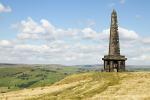
Stoodley Pike
more A war memorial in the Todmorden area
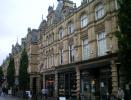
The Halifax Borough market
more The victorian covered market in the town centre
_1.jpg)
Square Church Spire
more The spire is all that remains of this church
_1.jpg)
The Piece Hall
more Halifax's jewel in the crown
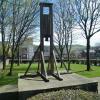
The Halifax Gibbet
more A forerunner of the Guillotine
Halifax Town Hall
more Seat of Local Governance

Dean Clough
more An industrial powerhouse of the past
_1.jpg)
All Souls Church
more The church of a former model village
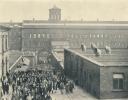
Black Dyke Mills
more An icon on the outskirts of Halifax
back to page above this...
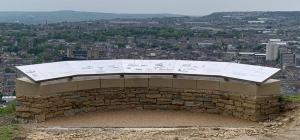
The Centenary Viewing Platform at Beacon Hill
back To celebrate 100 years of service to the town of Halifax we have commissioned viewing platform on Beacon Hill overlooking the town. Situated on the Magna Via, an old packhorse route, the walk to the top is worth it.